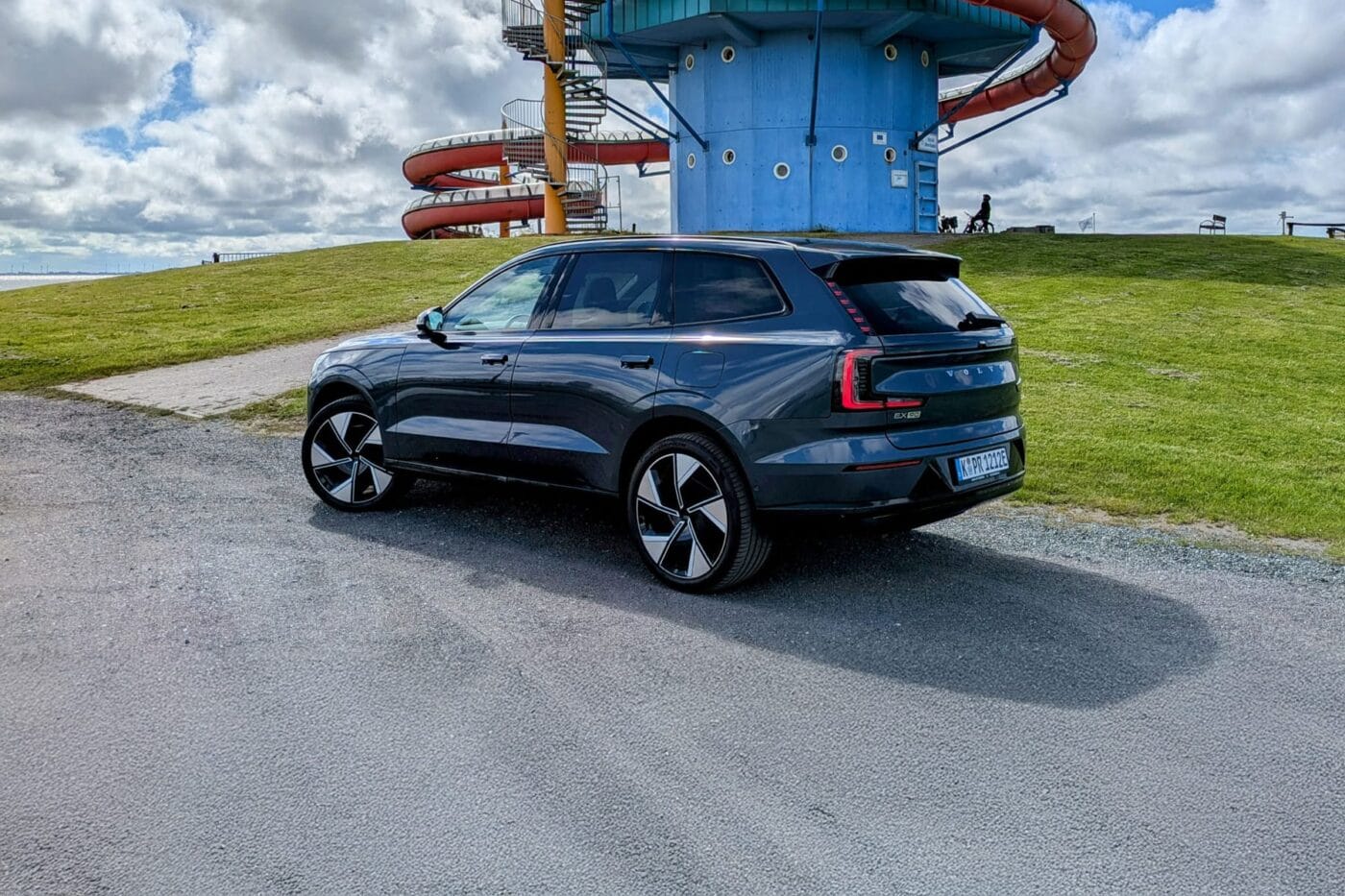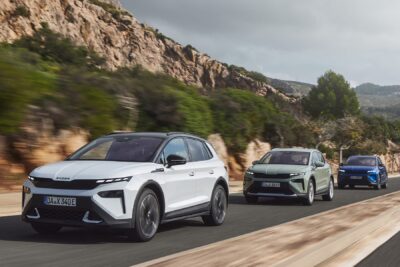
Volvo EX90 Single Motor Plus: the land cruiser
The Volvo EX90 doesn’t start up; it sets off as quietly as a sailing boat, even quieter than most other electric cars, and so very smoothly. The Volvo has very high rolling comfort, and the noise of the chassis is effectively damped. The EX90 is a land yacht. It is the alternative to the XC90, which has been on offer since 2002 and still has internal combustion engines. This is not just a difference in emissions, but also a cultural one: the electric drive is an ideal match for the cool elegance of the Swedish design. The price list starts at 83,700 euros. In the ‘Single Motor Plus’ equipment line, and adding in a few extras, the car we tested had a gross list price of 101,630 euros.
In the Volvo EX90, ‘Single Motor’ means: rear-wheel drive and 205 kilowatts (kW) of power. Enough power to accelerate the heavy car (the kerb weight is 2,605 kilograms) to 100 kph in 8.4 seconds. This is not particularly fast compared to other electric cars. The thrust is subjectively restrained at the pedal. With a little sobriety, everyone should realise that this power is sufficient in most situations.
2.2 tonnes towing capacity with the twin motor only
The towing capacity of the EX90 single motor is 1.2 tonnes; the surcharge for the clutch is 1,190 euros. Even if this is sometimes fobbed off as being unnecessary, SUV buyers do sometimes actually need more towing capacity. A family towing a caravan, for example, or a farmer at work, would have to opt for the Twin Motor (5,700 euros surcharge), which can tow 2.2 tonnes and has an output of 300 kW or even 380 kW as Twin Motor Performance.
In any case, the Volvo EX90 has plenty of space. With an exterior length of 5.04 metres, a width of 1.96 metres excluding side mirrors and a height of 1.74 metres, this is to be expected. The standard version comes as a 5-seater. The 6- or 7-seater configuration (both 2,300 euros each) can be ordered at an additional cost.












The test vehicle was a 6-seater, with a third row that can be electrically folded down and raised. When the seats in the second and third rows are folded, the result is an almost flat surface. The best way to access the third row is via the gap between the individual seats in the second row, which is quite easy for smaller people.
A cruiser with light in the room
The driving experience – see front – is characterised by a high level of comfort and a high seating position. One drawback is the panoramic roof, which can neither be opened nor shaded.
The Volvo EX90 undoubtedly tempts you to cruise. Yes, compared to its size and weight, it is surprisingly agile through bends, but ultimately, that is not what it is all about. Lean back and let it go.
Haptic levers for gear selection and indicators
Some functional strengths and weaknesses stand out. For example, the division between haptic controls and touchscreens can be considered a success. A selector lever for the gearshift and activation of Pilot Assist on the right, the indicator and windscreen wiper lever on the left – that fits. The software for the vertically aligned central display is based on Google Android Auto and is reliably error-free.
A number of functions are summarised here, and Volvo has gone overboard with the details: The exterior mirrors and the steering wheel can only be adjusted in some submenus. And the fact that there are not four, but two switches for the power windows, plus an additional switch that switches between the front and rear, as in the EX30, is not a great idea.
Assistance systems not in line with the class
On the other hand, the legally prescribed warning sound when exceeding the speed limit can be deactivated at a low level. As far as Level 2 assisted driving is concerned, the Volvo EX90 does its job well, but not quite as well as is usual in this segment.
The cruise control with distance control works pleasantly and gently; however, the Volvo does not have automatic traffic sign recognition. Such features are no longer a speciality in the C-segment, such as in the Volkswagen ID.3 with Travel Assist; in the luxury class, these are a matter of course.
This also applies to other details, such as restarting after coming to a standstill: the person at the wheel of the Volvo still has to confirm this by tapping the accelerator pedal. The lane centre guidance on the motorway, on the other hand, does what it should, making the journey a pleasure.
374 kilometres of real highway range
If you have a certain amount of discipline and don’t drive too fast, the random test at the recommended speed resulted in a consumption value of 27 kWh/100 kilometres. The onboard computer does not display decimal places. The factory specification for the energy content of the traction battery is 101 kWh, which results in 374 kilometres of range at 130 km/h. This is much less than in the WLTP measurement procedure (612 kilometres). However, everyone should check how often they travel significantly more than 300 kilometres without stopping.
This consumption value is very high compared to streamlined saloon cars, which easily achieve values of around 20 kWh/100 kilometres. Unfortunately, physics in the form of the EX90’s immense frontal area cannot be outwitted. Further individual consumption values: at 120 km/h, electricity consumption fell to 22 kWh/100 km; in interurban driving, it was 18 kWh/100 km and in flowing traffic in the city, this came to around 16 kWh/100 km. On the A7 and A1 motorways, the Volvo acknowledges its lead foot with values between 35 and 40 kWh/100 km.
Passable charging performance
The charging stop is no cause for enthusiasm because, despite preconditioning via the route planner, it took 29 minutes to charge from 15 to 80 per cent. However, this period is specified by the factory for 10 to 80 per cent, so the promise was only narrowly missed. The maximum charging power was 184 kW (factory specification: 250 kW). This may be okay in itself, and many users will have no problem with it.

Others will be waiting for the EX90 to switch from a 400 to an 800-volt battery system, so they can charge faster. That will still take some time. The ES90 saloon is already leading the way. Perhaps Volvo will also give the EX90 a 22 kW AC charger instead of 11 kW, which would be a practical addition in view of its energy content of over 100 kW.
Others will ask themselves what Swedish aesthetics are worth to them. After all, the Kia EV9 and the Hyundai Ioniq 9 are two competitors based on the 800-volt E-GMP platform. Here, the standard charge from 10 to 80 per cent takes 18 minutes. The Kia EV6 is available with a similar energy content (99.8 kWh) from 64,990 euros. The 6-seater with all-wheel drive and GT line package starts at 83,370 euros.
Desire for aesthetics
These are all sums for which private customers are an exception. Nevertheless, everyone should realise that there is a relevant customer base for such vehicles. These could be high-earning self-employed people or senior executives. Take a look at how much the Estate model of a Mercedes E-Class with plug-in hybrid drive costs. It sold pretty well in 2024.
The Volvo EX90 is therefore a dream purchase for those customers who want a Scandinavian design language, who need the space and at the same time have the necessary purchasing power. As an electric car, it may not be at the forefront due to its charging performance, and the assistance systems are merely okay instead of sophisticated. But that’s not the point. If you choose the Volvo, you get a deeply pleasant companion that makes you feel relaxed and safe. That’s how it should be.




0 Comments